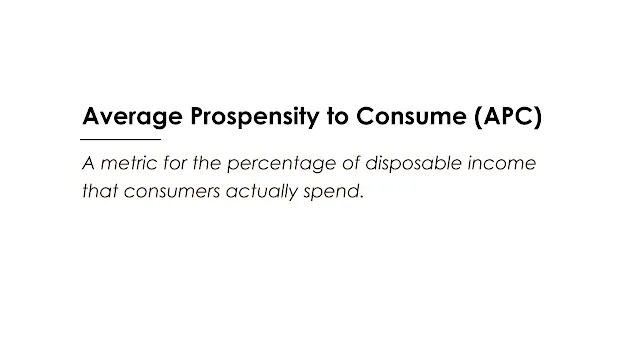
|
| Image: Moneybestpal.com |
The average propensity to consume (APC) is a metric for the percentage of disposable income that consumers actually spend. It is determined by dividing the total amount spent on consumption by the total amount of disposable income.
How much of each unit of income is spent on consumption is displayed by the APC. For instance, if the APC is 0.8, this indicates that 80% of income is used for spending while 20% is saved.
The APC can change based on customer choices, income level, and anticipated changes in prices and income in the future. APCs are often higher in low-income households than high-income households because they spend a bigger percentage of their income on needs and have less left over for savings.
In contrast, high-income households often have lower APCs than low-income households because they have more money available for saving and investing and spend a smaller percentage of their income on consuming.
Inflation, unemployment, interest rates, and economic development are some of the economic factors that might alter the APC over time. For instance, when income is down and uncertainty is up, consumers may cut back on spending and boost savings, which lowers the APC.
Contrarily, during an expansion, when income rises and confidence soars, consumers may increase their consumption while lowering their savings, which would raise the APC.
Data from national accounts, such as the GDP and disposable personal income (DPI), can be used to examine the APC. While the DPI gauges the total income available to households after taxes and transfers, the GDP gauges the total value of goods and services generated in an economy in a specific time frame. The personal income deflator (PID), which measures GDP to DPI as a ratio, represents the average cost of goods and services that households spend.
Using data from the U.S. Bureau of Economic Analysis (BEA), we can calculate the APC for the U.S. economy from 2010 to 2020 as follows:

|
| Image: Moneybestpal.com |
Note: The data for GDP and consumption expenditure are in current prices (nominal), while the data for DPI are in chained prices (real). The data for PID are calculated by dividing GDP by DPI in current prices.
According to the table, the APC for the American economy was essentially constant between 2010 and 2018, hovering around 0.8 or 0.9, which means that consumers spent 80% or 90% of their disposable income on consumption and saved 10% or 20%, respectively.
The COVID-19 pandemic's economic effects mean that the figures for 2019 and 2020 are not yet accessible. However, given the dramatic decrease in income and spending during this time, as well as the government's use of stimulus measures to aid individuals and companies, we can anticipate that the APC may have undergone significant adjustment.
Using the marginal propensity to consume (MPC), which is the amount by which consumption varies when disposable income changes by one unit, is one method of estimating the APC for 2019 and 2020.
The consumption function, a mathematical equation that depicts the link between consumption and disposable income while maintaining other elements constant, can be used to derive the MPC. The slope of the consumption function, which gauges how steeply consumption rises or falls as income changes, is equal to the MPC.
Using data from the BEA, we can estimate the MPC for the U.S. economy from 2010 to 2018 as follows:

|
| Image: Moneybestpal.com |
According to the data, the MPC for the American economy was largely steady between 2011 and 2018, hovering around 0.7 or 0.8, which means that consumers' spending changed by roughly 70% or 80% depending on how their disposable income changed.
By multiplying the change in DPI for these years by the average MPC of 0.75 for this period, we can calculate the change in consumption expenditure for 2019 and 2020. The BEA estimates that the DPI changed by $1,016 billion in 2019 and by -$1,029 billion in 2020.
As a result, we may calculate a $762 billion change in consumption spending for 2019 and a -$772 billion change in consumption expenditure for 2020.
Adding these estimates to the actual consumption expenditure for 2018, which was $13,375 billion, we can obtain the estimated consumption expenditure for 2019 and 2020 as follows:

|
| Image: Moneybestpal.com |
The predicted consumption expenditure for 2019 and 2020 can then be divided by the actual DPI for these years to yield the estimated APC for those years. The actual DPI in 2019 was $17,028 billion, and in 2020, it was $17,997 billion, according to the BEA. Therefore, we can calculate the estimated APC for 2019 and 2020 as follows:

|
| Image: Moneybestpal.com |
According to the data, the anticipated APC for the U.S. economy fell from 0.83 in 2019 to 0.70 in 2020. This indicates that consumers used around 83% of their disposable income for consumption in 2019 but only 70% in 2020, while saving, respectively, 17% and 30% of their income.
The decline in APC is due to both the favorable impact of government stimulus programs on household income and the detrimental effects of the COVID-19 epidemic on consumer spending and saving habits.
In conclusion, the average propensity to consume is a helpful measure of how consumers divide their income between spending and saving, as well as how they react to changes in the economy and expectations.
We may examine how the APC has changed over time and across various income categories in an economy by using information from national accounts and determining the marginal propensity to spend.





